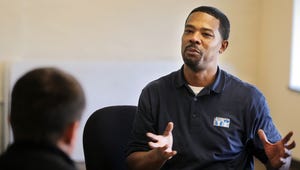That October morning he walked out of Allen Correctional Institution in Lima and into an uncertain future. His girlfriend drove him back home.
“All I knew until then was hustling in the streets,” said Duren, now 42. “I was setting out to rebuild my life, and I didn’t know how.”
His experience in overcoming the barriers a returning citizen faces is one of the reasons Duren was hired to coordinate a national pilot reentry program housed in Cincinnati’s St. Vincent de Paul Society. Among the goals of the program – which will hold a public information meeting Monday night, Feb. 23 – is to inform and engage Catholics about mass incarceration and reentry issues.
Business was good, until the night rival dealers robbed Duren’s partner. They plotted revenge, finally retaliating. Duren did not fire his gun, but his friend did, killing one of the opposing dealers.
Duren pled guilty in court to involuntary manslaughter and aggravated robbery, both felonies.
“I took a deal,” he said. “The public defender couldn’t remember my name.”
In prison, he learned data entry and earned an associate’s degree in business administration.
“I did everything I could to make myself employable when I got out,” Duren said. “I stayed busy, but in prison you have to deal with yourself. I did a lot of self-reflection.”
Catholic reentry effort seeks to cut poverty
There are a lot of Dominic Durens in Ohio.
The Ohio Department of Rehabilitation and Correction released more than 21,000 prisoners in calendar year 2012, not counting inmates still under local transitional control.
That year, 1,940 prisoners who had been committed from Hamilton County were released – 566 from Butler County, 376 from Clermont and 261 from Warren.
Hamilton County created a reentry office to help former prisoners find housing and work, get a driver’s license and clear up problems such as overdue child support payments. Cincinnati Works started its Phoenix Program with many of the same goals and to prepare former convicts for the workplace. The Urban League of Greater Cincinnati’s SOAR job-readiness program – the acronym stands for Solid Opportunities for Advancement and Retention – is not designed for returning citizens but attracts many of them. The HELP Program at St. Francis de Sales Church, Walnut Hills, where Duren first received help in 2009, is faith-based and run by a religious Marianist Brother, Mike Murphy.
St. Vincent de Paul’s program – Duren is its coordinator – is different. It grew out of a partnership between the Cincinnati Archdiocese and the Amos Project, a West End-based coalition of 30 congregations committed to social justice. They were successful in leading the effort around Ohio to win fair-hiring policies, otherwise referred to as ban-the-box, which removed the box on job applications that asked if the applicant had a felony record.
Paid for by the Catholic Campaign for Human Development, an anti-poverty program of the US Conference of Catholic Bishops, the St. Vincent de Paul Reentry Program takes aim at poverty. Up to 20 percent of the nation’s poverty is caused by its mass incarceration system and the laws and stigma that follows ex-offenders when they try to get jobs, places to live and loans and even when they try to vote, according to a 2014 National Academy of Sciences report requested by the U.S. Department of Justice and other organnizations.
The cost of housing prisoners is another drain on society. It costs Ohio taxpayers $24,784 to care for a prisoner in the state’s prisons. Locally, the care of an inmate at the Hamilton County Justice Center costs $65 a day – or $23,725 a year. The justice center has an average daily inmate population of 1,424.
Besides trying to engage Catholics in prison ministry and the reentry movement, the St. Vincent de Paul program seeks to support and coordinate with other reentry programs that provide direct services.
Cincinnati is just one of four Catholic dioceses nationwide chosen to start the pilot program, along with Milwaukee, Boston and Orlando. The former director of Cincinnati’s AMOS Project, Paul Graham, heads the national St. Vincent de Paul-based reentry efforts.
“We are trying to end poverty through systematic change,” Graham said. “Home visits (a staple of St. Vincent de Paul’s efforts in the past) aren’t enough. We need to be involved more deeply. We’re bringing Catholics into a new understanding of criminal justice alternatives for drug addition.”
Duren returns to streets before program sticks
In 2009. Duren had contact with Cincinnati’s St. Vincent de Paul office on Bank Street in the West End – as a client.
“I stood in line out on the street for a winter coat,” he said. “I couldn’t even afford my own jacket.”
His girlfriend, whom he would later marry, was living on student loans and finishing a nursing degree at Northern Kentucky University. With two felonies, Duren could not find work. Construction jobs never materialized. He said he gave into despair in 2009 and returned to the streets of Cincinnati to sell drugs, all in the name of trying to support his family.
The couple’s son was born prematurely and spent 10 weeks in the neonatal intensive care unit. (The boy is now 5 and healthy; Duren and his wife also have a 2-year-old daughter.)
“I had needs – right now,” Duren said of his life in 2009.
He had met Brother Mike at the HELP Program. He fell away from the process twice. The third time he stuck.
“I never had experienced so much compassion; I didn’t feel worthy,” Duren said. “They did so much for me and my family. They gave me a chance when nobody else would.”
Before long, Murphy hired Duren and promoted him to run the program.
“He was my director here for three years,” Murphy said. “He has excellent administrative skills, better than mine. His greatest gift is his passion. He is going to dedicate his life to what he is doing at St. Vincent de Paul.”
Duren’s strengths are evident in his first year there.
“He’s humble, honest and caring,” said Don Meyer, a deacon and coordinating chaplain for Catholic ministries at the Hamilton County Justice Center. “He recognizes the mistakes in his past and so clearly identifies with people’s struggles. He is the perfect person for this job.”
Said Tony Stieritz, director of Catholic Social Action in the Cincinnati Archdiocese, “In one word, because of who he is and the network of solidarity that surrounds him, what Dominic uniquely brings (to) this whole effort is hope.”
MASS INCARCERATION BY THE NUMBERS
• The United States leads the world with 2.2 million people now in its prisons and jails, meaning that 1 of every 100 Americans are behind bars.
• National incarceration rates have dropped in the past three years, but the overall incarceration rate increased 500 percent in the past 30 years.
• 65 million Americans have a criminal record, 19.8 million with felony convictions.
• 51,729, Ohio state prison inmate population.
• 12,111, Kentucky state prison inmate population.
• 1 in 28 American children has an incarcerated parent.
• 1 in 4 African-American children has a parent in prison or jail.
• 1 in 3 African-American males born today will go to prison at some point in their lives, if trends continue.
• 1 in 100 African-American women are incarcerated.
• Though they make up only 25 percent of the U.S. population, African-Americans and Hispanics comprise 58 percent of all prisoners.
• In September 2012, Ohio passed the Collateral Sanctions Reform Bill, which removed or revised 675 statutes that blocked former offenders from getting jobs in some of the state’s largest employment sectors, such as health care and education.
• Ohio’s rate of repeat offenders – recidivism rate – continues to drop: from 34 percent in 2011, to 28.7 percent to 27.1 in fiscal year 2014.
Sources: U.S. Conference of Catholic Bishops, the Pew Charitable Trust, NAACP, Ohio Department of Rehabilitation and Correction


